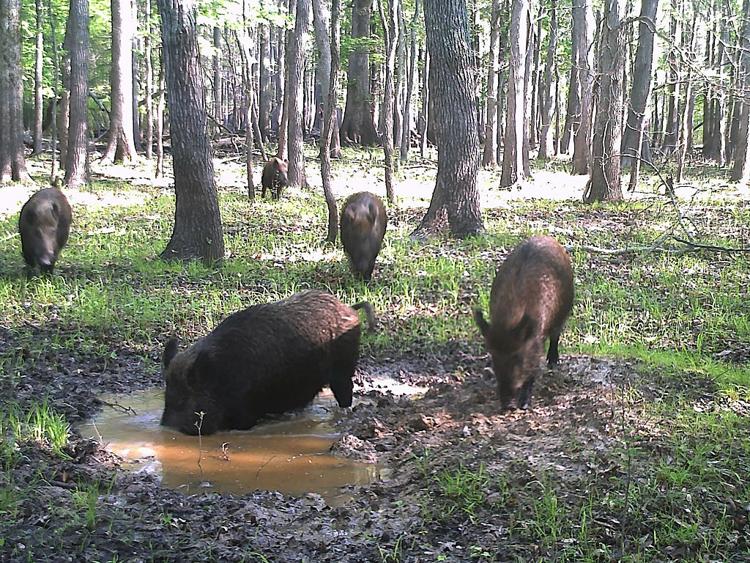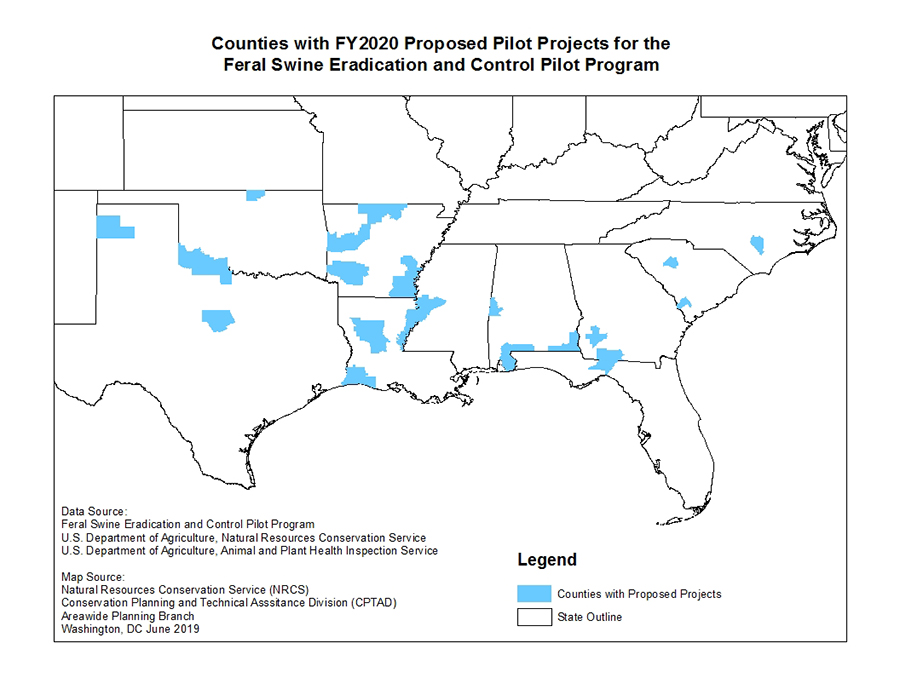
A new report by several experts confirms fears that the feral pig threat is widespread and re-emphasizes the value of taking action early. (I have blogged several times about efforts to manage damaged caused by feral hogs – see here and here.
Lewis et al. (full reference at end of blog) used two national-scale data sets to estimate historical, current, and future potential population size of wild pigs in the U.S. from 1982 to 2016.
They found that both wild pig distribution and abundance have nearly tripled over this period (from ~2.4 to 6.9 million). If no effective action is taken and pigs spread to all available habitat, the U.S. wild pig population could reach ~21.4 million at some unspecified future date. This would represent a 210% increase above the 2016 population; or a 784% increase above the 1982 population.
The authors cite successful control of wild pigs in Colorado, New Mexico, Michigan, and Nebraska as evidence of the value of early detection and rapid response.
Lewis et al. provide brief summaries of economic and ecological damage caused by feral hogs. They damage a wide range of ecological communities, especially riparian areas, grasslands, and deciduous forests. Biological diversity is hurt through habitat destruction, direct predation, and competition for resources. In addition, wild pigs can host a suite of viruses, bacteria, and parasites, many of which can be transmitted to other wildlife, humans, and livestock.
The report notes that much of the recent spread of pigs has been caused by widespread and illegal releases of wild animals for sport hunting. Other contributing factors are land-use patterns, because hogs do well in agricultural areas. Warmer winter temperatures and increased forest mast production are also to blame – both related to climate-change
Wild pigs can persist in a range of environments, including cold northern climates, arid regions, and mixed forests. That is, all regions of the continental U.S. The vast majority of states – especially in the West, North, and East – could see major expansions in wild pig populations if animals are allowed to become established over currently unoccupied habitat.
While states that have had large established wild pig populations – e.g., Texas, California, and Florida – will not see major expansions, damage is already severe and widespread. Texas alone has an estimated 2.5 million feral hogs!
Preventing the alarming expansion of feral hog populations outlined above, Lewis et al. call for adoption and implementation of proactive management. The priority is to quickly identify and eradicate populations that invade unoccupied habitat. This applies particularly to those states which currently have low populations of feral hogs.
The same approach can be applied within states. Officials can use one data set to identify areas where wild pigs are currently absent and the predicted population density data to designate priority areas to counter spread. Such efforts should include public education and outreach, regulatory enforcement, and surveillance.
Lewis et al. note that implementation of the proposed strategy will require a coordinated effort among federal, state, and local governments and the public. They call especially for state regulations classifying feral hogs as an invasive and harmful species supported by action to halt pig translocation for the purposes of recreational sport hunting.
The authors promised that the findings of the study would be applied by the National Feral Swine Damage Management Program, which is led by USDA APHIS. One of the “tactics” to achieve Objective 2.4 in the APHIS Strategic Plan for 2019-2023 says the agency will “expand feral swine damage management for agricultural, livestock, property, ecological and human health and safety purposes.” Still, states will find it challenging to take any actions opposed by hunters.
At the end of June 2019, the U.S. Department of Agriculture (USDA) announced a $75 million program called the Feral Swine Eradication and Control Pilot Program (FSCP). (This works out to about $15 million per year.) The program is a joint effort by the Natural Resources Conservation Service (NRCS) and APHIS. It was established by the 2018 Farm Bill. Additional information is available at the program webpage.
The webpage describes how to apply for funding for projects lasting up to three years. The pilot projects will consist broadly of three coordinated components: 1) feral swine removal by APHIS; 2) restoration efforts supported by NRCS; and 3) assistance to producers for feral swine control provided through partnership agreements with non-federal partners.
The initial funding will target specific locations in the South that have experienced recent increases in wild pigs (shown on the map below). The goal is to reduce the numbers of pigs (and associated damage) in those identified localized areas of the South. These “pilot” areas have been identified by the USDA Secretary as under threat from feral swine. The first round of projects – 20 projects – are targetted at a few counties in Alabama, Arkansas, Florida, Georgia, Louisiana, Oklahoma, North Carolina, South Carolina, and Texas. APHIS has determined these states and California have highest feral swine populations.
The new program builds on successes in recent years. Funding of APHIS’ feral hog program at about $20 million per year has helped several states become “pig free”. Idaho, Iowa, Maine, New Jersey and New York are currently monitoring (using eDNA and scat dogs) to make sure that the pigs are truly gone.

SOURCE
Lewis, J.S., J.L. Corn, J.J. Mayer, T.R. Jordan, M.L. Farnsworth, C.L. Burdett, K.C. VerCauteren, S.J. Sweeney, R.S. Miller. 2019. Historical, current, and potential population size estimates of invasive wild pigs (Sus scrofa) in the United States. Biological Invasions, Vol. 21, No. 7, pp. 2373-2384.
Posted by Faith Campbell
We welcome comments that supplement or correct factual information, suggest new approaches, or promote thoughtful consideration. We post comments that disagree with us — but not those we judge to be not civil or inflammatory.
Have wild boars ever entered people’s gardens or farm fields and caused damage?
yes; there is lots of documentation of damage to farm fields. Not sure about gardens, but I see no reason to think it would not happen.